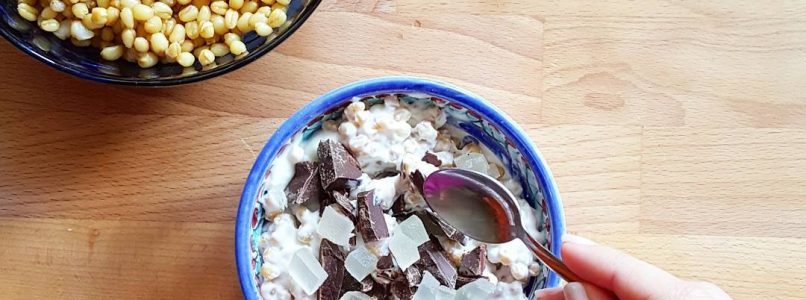We eat only one day a year. We eat in the area of Palermo and Syracuse. We eat mainly in the family. It is the sweet of Saint Lucia. Here is the recipe
There was a time when Sicilian desserts were a privilege only for a few. The cost of raw materials – in particular sugar – made them prohibitive for the people and were prepared, for the clergy and nobility, only by the skillful and quick hands of the nuns. The older women jealously kept the recipe books inside the walls, steeped in silence and prayer, of monasteries. These sweet temptations also had a close connection with the religious calendar, and every anniversary was celebrated with an exquisite delicacy.
The legend
On December 13 – the day of the festivities in honor of Saint Lucia – in the monastery of Palermo dedicated to her, cuccìa was prepared, a typical Sicilian sweet made from boiled wheat with ricotta cream. The custom of consuming wheat is linked to the memory of the miracle performed by the Christian martyr when, in 1646, he brought a grain-laden ship to the Sicilian capital after a long famine that had starved the population. In order to consume it immediately, the grain was not ground, but boiled and eaten. In memory of that day, the Palermo – but also the Syracusans, given that the Saint is the patron saint of the Aretusian city – on December 13 renounce the starchy foods, consuming only vegetables, legumes, panelle and cuccìa, or soaked and boiled grain. For the ancient Greeks, wheat was a propitiatory food, a symbol of life and fertility.
The cuccìa
Over the years, even the feast of Saint Lucia, like all other religious celebrations, has lost the connotation of fasting and penance to become a pretext for great binge eating arancine and other delicacies (other than bread and pasta). There are even those who have jokingly renamed this day as the Arcanina day. Among the most famous gastronomic symbols of Sicily in the world, the arancine are consumed throughout the year, even outside the island's borders. There cuccìa, instead, it is a food less known and prepared within the domestic walls, by mothers and grandmothers, only on December 13: there is no Palermo that has not tasted this cake at least once. Today in Palermo the cuccìa is made with boiled wheat, seasoned with sweet cocoa cream, with blancmange or with sweet ricotta. It is then garnished with zuccata, cinnamon and small pieces of chocolate and is consumed together with the arancine on the occasion of the feast of Saint Lucia.
The ancient convent recipe
Below, the original conventual recipe of the cuccìa, as reported by Maria Oliveri in the volume The secrets of the cloister. Stories and recipes of the monasteries of Palermo.
Ingredients
500 g wheat, a pinch of salt, 1.5 kg fresh sheep's milk ricotta, 450 g caster sugar, 300 g angel hair, 150 g dark chocolate (in drops or pieces), chopped pistachios q.b., cinnamon powder q.b.
Method
Put the wheat in water for three days before preparing the kennel, changing the water every day. Drain the wheat and place it in a pan, covering it with water and adding a pinch of salt. Cook for 6-8 hours at very low heat, leaving it to rest in the cooking water, covered with a lid, overnight. Separately, to prepare the cream, whisk the ricotta, previously sieved, with the sugar in a rather large bowl. Add the angel hair cut into small pieces and drops of dark chocolate. Drain the cold wheat well and add to the cream, mixing the mixture. Serve in small bowls, sprinkling with cinnamon powder, or chopped pistachios or dark chocolate or diavolini.
The 6 pastry shops where to eat, on Saint Lucia's day (December 13th), the best cuccìa in Palermo
• The Secrets of the Cloister (Monastero Santa Caterina) – Piazza Bellini
• Pasticceria Costa – via Maqueda 174
• Pasticceria Oscar 1965 – via Migliaccio 39
• Pasticceria Cappello – via Colonna Rotta 68
• Pasticceria Magrì – via Isidoro Carini 42
• Antico Caffè Spinnato – via Principe di Belmonte 107
Photo: Ornella Daricello and Salvatore Spatafora.
This recipe has already been read 246 times!
